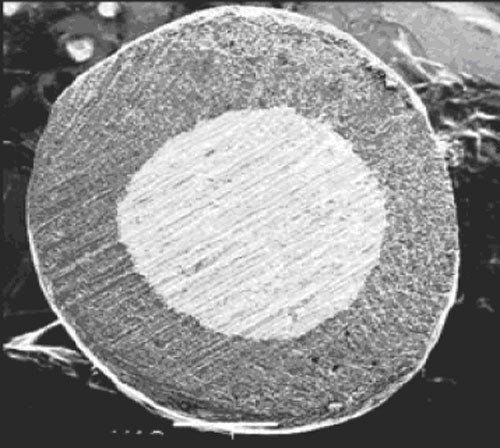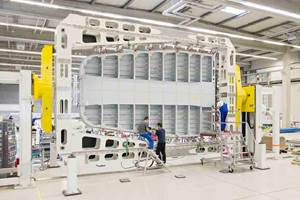New filament to make composites "smart"
CW Conferences director Scott Stephenson premiers a showcase for new ideas overheard at CW Conferences.
Smart composites — those able to convey data and information in real time — are going to get even smarter with the advent of a new conductive microwire now in the commercialization stage at EY Technologies (Fall River, Mass.). In keeping with its history of unique fiber-based product developments for OEMs, the company decided six years ago to pursue a continuous, weavable fiber capable of power and data transfer, using monies from U.S. Department of Defense Small Business Innovation Research (SBIR) grants under the auspices of the U.S. Army. The outcome, the patented iCon fiber, is made with a metallic core and a polymer sheath, says company president Gerry Mauretti: “Our primary purpose was to develop a smart fiber for wearable textile fabrics, such as military uniforms, that could convey communication and data signals or for temporary military shelters with the same capability. But the iCon fiber has a lot of potential for the composites industry as well.” Mauretti recently described his company’s efforts at CompositesWorld’s 2010 High-Performance Fibers conference in Charleston, S.C. (see "2010 review: High-Performance Fibers Conference," under "Editor's picks," at top right).
Fiber characteristics
Using techniques taken from the optical-fiber industry, EY Technologies creates the continuous fiber using a double crucible fiber-drawing process in which molten indium alloy is drawn through a liquid, textile-grade polymer via a drawing die to create a fiber with a metallic inner core surrounded by an insulating polymer sheath — essentially a co-pultruded process. As the fiber exits the die, it is air quenched, drawn, annealed and taken up on spools. The core-to-cladding ratio is approximately 60:40. According to Mauretti, the fiber is very flexible and is capable of up to 10 percent strain with full recovery. By comparison, a drawn metallic wire typically can withstand only 2 percent strain. This characteristic makes iCon easy to conform so it can be integrated into weaving operations for fabrics. The textile-grade polymer sheath can be customized to a customer’s application, and Mauretti says that polyester, nylon, polycarbonate and other materials are available in multiple colors and finish options.
The standard iCon fiber is 75 microns in diameter (custom sizes are available) and about 4 to 10 times the diameter of a typical carbon fiber. The tensile strength is 40 to 70 ksi, with stress-strain behavior similar to a 22 dtex nylon textile fiber (dtex is one-tenth of a tex, where tex is equal to the weight in grams of 1 km of linear fiber). The price-competitive indium alloy core has about 25 percent the conductivity of pure copper and about one-third the conductivity of gold, and it is much more conductive than stainless steel or ferrous metal.
A considerable effort is made to ensure fiber quality during manufacture. The metal core is continuously inspected to ensure uniformity, concentricity and the absence of defects, such as necking or voids. Likewise, the clad is continuously inspected to ensure uniform diameter, smoothness and the absence of defects, such as necking or fish eyes. Mauretti says the company can produce and deliver the iCon microwire in commercial quantities, typically 5,000m/16,250-ft spools, and multiple forms, such as a single-filament conductor, a multiple-filament conductor or combined with textile fibers. Although connectivity is a bit of a challenge for fabrics, Mauretti says that for composites, soldered or crimp connections are feasible, and they are compatible with metal clips or even USB plug-ins.
Testing shows promise
EY Technologies has subjected the fiber to extensive test regimes, including one in which lengths of filaments were embedded in epoxy resin to form coupon samples that were subjected to cyclic loading in tension while resistivity was measured. The data clearly show that iCon fibers can act as strain gages because electrical resistance in the filament changes in a consistent and repeatable manner as the load increases. Additional tests have shown a similar relationship between resistivity and temperature.
The data indicate a role for iCon filaments in composite cure monitoring. Says Mauretti, “The fibers can be woven into the reinforcing fabrics in the part or into the tool face itself.” The polymer sheath chemistry can be optimized for compatibility with any resin, and the fiber can withstand typical autoclave or oven temperatures.
Several customers are testing samples of the material in various applications, and the fiber shows promise for delivering multiple benefits. For example, the same fiber could enable cure monitoring during fabrication and then act as a strain sensor when the part is in use. Mauretti reports that automotive applications also look promising and that electromagnetic shielding may be investigated as well. “This is one link in the chain of getting more functionality from composites,” he concludes.
The 2011 Wind and Ocean Energy Seminar, CompositesWorld’s next and newest conference, will explore the market for composites in wind and ocean energy technology, April 13-14 in Portland, Maine (see ad on p. 8). W&OES is co-organized with the Maine Composites Alliance. For more information, contact conference manager, Scott Stephenson, E-mail: scott@compositesworld.com, Tel.: (207) 221-6602, or contact co-organizer Maine Composites Alliance’s Stephen Von Vogt, E-mail: svonvogt@mainecompositesalliance.org, Tel.: (207) 828-1414 or visit http://www.compositesworld.com/conferences/2011-wind-and-ocean-energy-seminar.
Related Content
Plant tour: Albany Engineered Composites, Rochester, N.H., U.S.
Efficient, high-quality, well-controlled composites manufacturing at volume is the mantra for this 3D weaving specialist.
Read MoreMFFD thermoplastic floor beams — OOA consolidation for next-gen TPC aerostructures
GKN Fokker and Mikrosam develop AFP for the Multifunctional Fuselage Demonstrator’s floor beams and OOA consolidation of 6-meter spars for TPC rudders, elevators and tails.
Read MoreFrom the CW Archives: Airbus A400M cargo door
The inaugural CW From the Archives revisits Sara Black’s 2007 story on out-of-autoclave infusion used to fabricate the massive composite upper cargo door for the Airbus A400M military airlifter.
Read MoreGKN Aerospace, Joby Aviation sign aerostructures agreement
GKN Aerospace will manufacture thermoplastic composite flight control surfaces for Joby’s all-electric, four-passenger, composites-intensive ride-sharing aircraft.
Read MoreRead Next
VIDEO: High-volume processing for fiberglass components
Cannon Ergos, a company specializing in high-ton presses and equipment for composites fabrication and plastics processing, displayed automotive and industrial components at CAMX 2024.
Read MoreAll-recycled, needle-punched nonwoven CFRP slashes carbon footprint of Formula 2 seat
Dallara and Tenowo collaborate to produce a race-ready Formula 2 seat using recycled carbon fiber, reducing CO2 emissions by 97.5% compared to virgin materials.
Read More“Structured air” TPS safeguards composite structures
Powered by an 85% air/15% pure polyimide aerogel, Blueshift’s novel material system protects structures during transient thermal events from -200°C to beyond 2400°C for rockets, battery boxes and more.
Read More

























